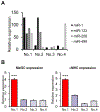Optimizing delivery for efficient cardiac reprogramming
- PMID: 32917363
- PMCID: PMC8339574
- DOI: 10.1016/j.bbrc.2020.08.104
Optimizing delivery for efficient cardiac reprogramming
Abstract
Following heart injury, cardiomyocytes, are lost and are not regenerated. In their place, fibroblasts invade the dead tissue where they generate a scar, which reduces cardiac function. We and others have demonstrated that combinations of specific miRNAs (miR combo) or transcription factors (GMT), delivered by individual lenti-/retro-viruses in vivo, can convert fibroblasts into cardiomyocytes and improve cardiac function. However, the effects are relatively modest due to the low efficiency of delivery of miR combo or GMT. We hypothesized that efficiency would be improved by optimizing delivery. In the first instance, we developed a multicistronic system to express all four miRNAs of miR combo from a single construct. The order of each miRNA in the multicistronic construct gave rise to different levels of miRNA expression. A combination that resulted in equivalent expression levels of each of the four miRNAs of miR combo showed the highest reprogramming efficiency. Further efficiency can be achieved by directly targeting fibroblasts. Screening of several AAV serotypes indicated that AAV1 displayed tropism towards cardiac fibroblasts. Combining multicistronic expression with AAV1 delivery robustly reprogrammed cardiac fibroblasts into cardiomyocytes in vivo.
Keywords: Cardiac reprogramming; Cardiomyocytes; Stoichiometry; miRNAs.
Copyright © 2020 Elsevier Inc. All rights reserved.
Conflict of interest statement
Declaration of competing interest The authors declare the following financial interests/personal relationships which may be considered as potential competing interests: Victor Dzau and Conrad Hodgkinson are co-founders of Recardia Therapeutics. Please note that all Biochemical and Biophysical Research Communications authors are required to report the following potential conflicts of interest with each submission. If applicable to your manuscript, please provide the necessary declaration in the box above.
Figures




References
-
- Heidenreich PA, Trogdon JG, Khavjou OA, Butler J, Dracup K, Ezekowitz MD, Finkelstein EA, Hong Y, Johnston SC, Khera A, Lloyd-Jones DM, Nelson SA, Nichol G, Orenstein D, Wilson PW, Woo YJ, American C Heart Association Advocacy Coordinating, C. Stroke, R. Council on Cardiovascular, Intervention, C. Council on Clinical, E. Council on, Prevention, A. Council on, Thrombosis, B. Vascular, C. Council on, C. Critical, Perioperative, Resuscitation, N. Council on Cardiovascular, D. Council on the Kidney in Cardiovascular, S. Council on Cardiovascular, Anesthesia, C. Interdisciplinary Council on Quality of, R. Outcomes, Forecasting the future of cardiovascular disease in the United States: a policy statement from the American Heart Association, Circulation 123 (2011) 933–944. 10.1161/CIR.0b013e31820a55f5. - DOI - PubMed
Publication types
MeSH terms
Substances
Grants and funding
LinkOut - more resources
Full Text Sources

